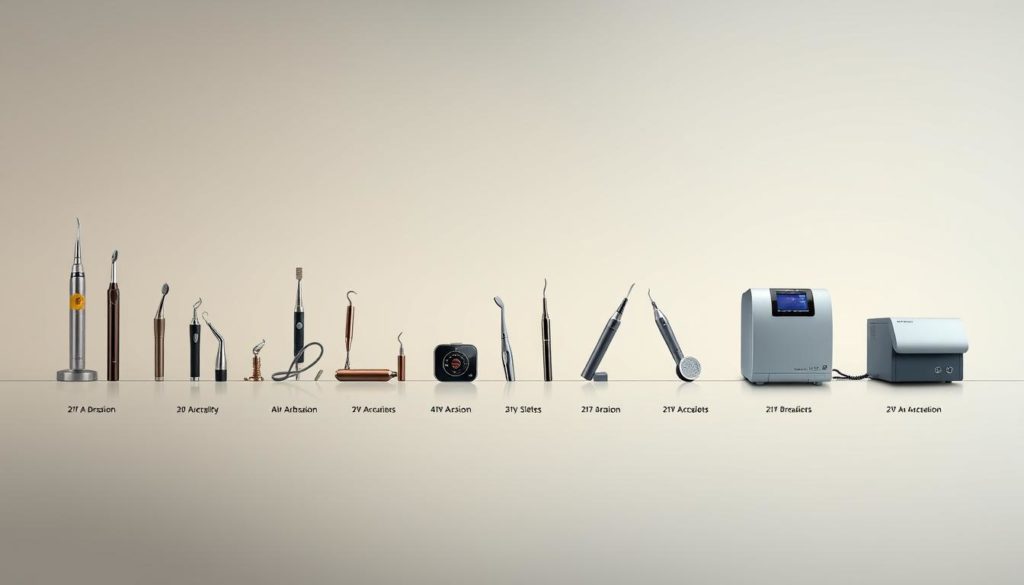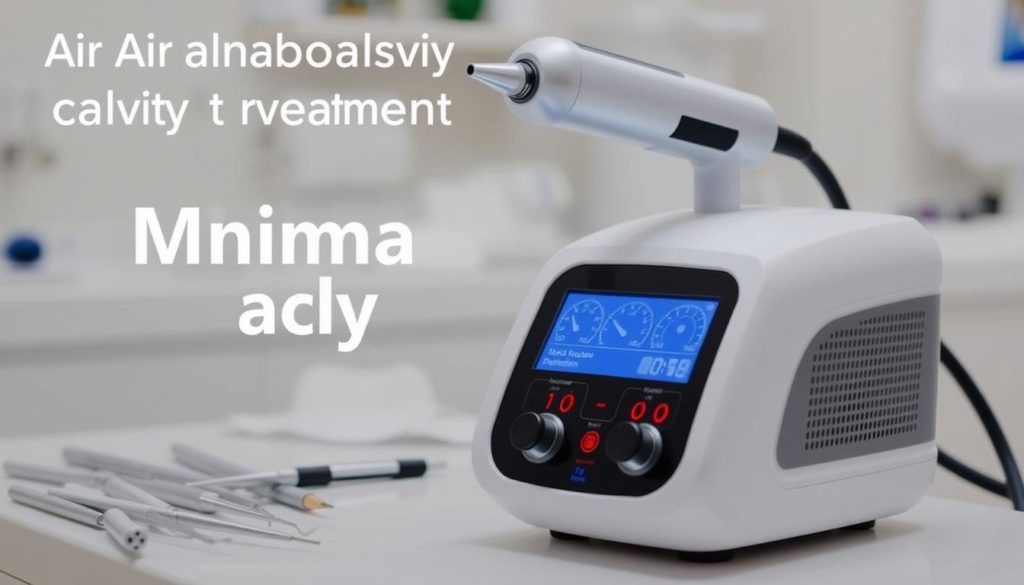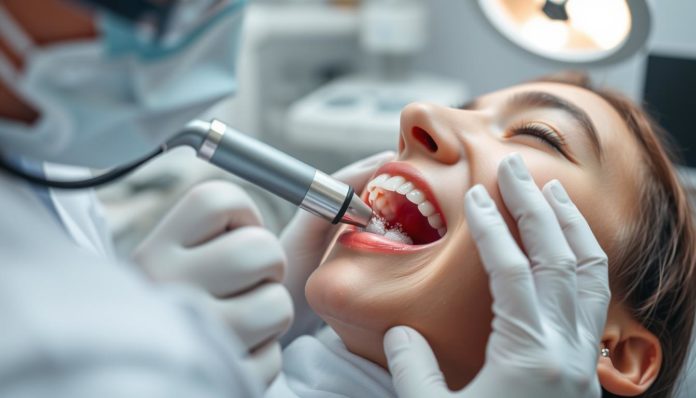Did you know nearly 75% of Americans dodge the dentist due to fear? They’re scared of the drill for cavity fixes. But, a minimally invasive procedure is changing the game. It’s called Air Abrasion, a gentle cavity treatment. It lessens pain and fear significantly.
This advanced dental technique does something cool. It blasts away decay with a mix of fine powder and air. No drill needed. As a non-invasive treatment, it keeps more of your tooth healthy. It’s great for easing fears and helps even kids feel okay at the dentist. Often, you won’t even need to be numbed up.
Air Abrasion isn’t just for cavities. It boosts many parts of dental health. It makes the dentist’s office a better place for everyone. Discover how this tech is making smiles brighter and visits easier.
What is Air Abrasion?
Air Abrasion is a modern dental technology used for removing tooth decay. It also prepares the tooth surface before applying bonds or sealants. This technique is less invasive than traditional drilling methods, marking a big change in modern dental care.
Understanding the Process
The Air Abrasion process is like using a mini sandblaster on your teeth. It sprays tiny particles, usually aluminum oxide, to clean off decay. This dental technology allows dentists to focus only on decayed areas. It makes the treatment less painful and more comfortable for patients.

History of Air Abrasion in Dentistry
Looking into the history of Air Abrasion, it started in the mid-20th century. At first, people didn’t welcome it warmly. But, huge improvements in dental technology have boosted its use and acceptability. Now, it makes dental visits less scary and more friendly for patients.
How Air Abrasion Works
The Air Abrasion system brings a new touch to fighting tooth decay. It avoids the drill, using compressed air and tiny abrasive particles instead. This method targets and removes the decayed parts of the tooth carefully.

The Mechanism of Action
By shooting a fine spray of abrasive particles, the Air Abrasion system gets to work. These particles, often aluminum oxide, are aimed precisely with a handpiece. The compressed air sends these particles to the decay, removing it while keeping the good tooth safe. This accuracy has made Air Abrasion a go-to for many dentists.
Materials Used in Air Abrasion
For dental procedures, choosing the right materials is crucial. Air Abrasion uses aluminum oxide. This is because it’s safe and works well against tooth decay. The particles are super fine. This ensures they clean thoroughly without harming the tooth. Through this, Air Abrasion allows for detailed and gentle dental care.
Advantages of Air Abrasion Over Traditional Drilling
Air Abrasion has many benefits over traditional drilling in dentistry. A key advantage is increased patient comfort. Unlike traditional drills, which can be quite uncomfortable due to vibration, heat, and noise, Air Abrasion does not have these issues. It offers a pain-free experience. This is especially good for people who fear dental visits or have sensitive teeth.
Another big plus is the preservation of healthy tooth structure. Traditional drilling might remove too much tooth material. But Air Abrasion is more precise and keeps more of the healthy tooth intact. This is better for your dental health over time and helps avoid future dental problems.
Air Abrasion often means you don’t need local anesthesia. Getting shots for anesthesia can be a bad experience for many. Since Air Abrasion can skip the numbing shots, it makes dental care more comfortable and pain-free.
The move to Air Abrasion is a big step forward in dentistry. Here’s a table showing the main differences between Air Abrasion and traditional drilling:
| Aspect | Traditional Drilling | Air Abrasion |
|---|---|---|
| Patient Comfort | Low (vibration, heat, noise) | High (pain-free dentistry) |
| Tooth Preservation | Less precise, more tooth removal | More precise, better tooth preservation |
| Anesthesia Required | Usually required | Often not needed |
The benefits of Air Abrasion make it a top choice for dental care today. It improves comfort, offers pain-free treatment, and focuses on saving your teeth. This is why it’s seen as a game-changer in the dental world.
Is Air Abrasion Suitable for All Patients?
To figure out if air abrasion is right, we need to look closely at who it’s for and key details of the treatment. This approach works well for certain people and specific cavity types. It’s gentle and less scary for patients.
Eligible Candidates
Air abrasion is great for kids, those who fear the dentist, and anyone with small cavities. It doesn’t remove as much of the tooth, keeping it stronger overall. This technique is particularly advantageous for kids because their teeth are smaller, and they often fear dentist visits. For those scared of the noise and feel of drilling, this method can be a relief.
Limitations and Considerations
But, air abrasion isn’t perfect for everyone. It struggles with deeper cavities where drills do better. Dentists think about things like where the decay is, how the patient takes care of their teeth, and if there are any fillings already. They must talk with the patient to see if air abrasion is the best choice.
| Factors | Air Abrasion Suitability | Considerations |
|---|---|---|
| Target Patient | Children, Anxious Patients | Compliance and Comfort |
| Cavity Depth | Shallow | Not Ideal for Deep Cavities |
| Cavity Location | Enamel Surface | Visibility and Accessibility |
| Patient Oral Hygiene | Consistently Monitored | Impact of Hygiene Practices |
The Procedure: What to Expect During Air Abrasion Treatment
Getting an air abrasion treatment is both simple and quick. It’s a method that many patients like because it’s not invasive. It also has a fast and gentle process. Let’s dive into what you’ll go through:
Pre-treatment Preparation
Your dentist gets things ready before starting the air abrasion treatment process. This includes using a rubber dam to protect nearby teeth. You’ll also get protective eyewear to keep your eyes safe during the procedure.
Step-by-Step Process
The air abrasion treatment process begins with your dentist targeting the decay. This method is great because it’s very accurate. It only removes the damaged enamel while keeping the good parts of the tooth safe. The whole thing is done quickly, causing little to no upset to nearby teeth and gums.
Aftercare and Recovery
Following the procedure, it’s key to stick to aftercare instructions for the best recovery. Mostly, this means keeping up with your usual dental care. The great part is that you won’t have to pause your daily life. Sticking to proper dental patient care after your treatment helps keep your mouth healthy for a long time.
Applications of Air Abrasion in Modern Dentistry
Air Abrasion has become a key player in modern dentistry. It offers a less invasive option compared to traditional methods. It uses new dental technology and is becoming more popular in different dental treatments.
Common Uses of Air Abrasion
Air Abrasion often tackles minor tooth decay. It uses a fine particle stream targeted at decayed spots. This process removes advanced tooth decay with less discomfort than drilling. Air Abrasion is also used for:
- Preparing tooth surfaces for sealants or bonding
- Repairing worn, chipped, or fractured teeth
- Removing superficial stains and discolorations
Innovative Developments
The world of innovative dental technology is always advancing. Air Abrasion continues to evolve. Recent improvements have made this tool more precise and easier to control. These upgrades allow for more customized and efficient patient care.
New technologies are being paired with Air Abrasion too. Below, you’ll see how it compares with other recent dental tech advancements:
| Technology | Usage | Benefits |
|---|---|---|
| Air Abrasion | Decay removal, surface preparation, stain removal | Minimally invasive, precise, comfortable |
| Laser Dentistry | Tissue cutting, decay removal, whitening | High precision, often painless, quick recovery |
| Ozone Therapy | Decay removal, sterilization, inflammation reduction | Non-invasive, antibacterial, promotes healing |
These technologies show how important Air Abrasion is. It works well with other new dental techs to better patient care.
Comparing Air Abrasion with Other Minimally Invasive Procedures
Air Abrasion stands out in minimally invasive dental treatments. It’s known for its accuracy and less discomfort. However, other techniques also offer unique benefits.
Laser Dentistry
Laser dentistry uses focused light to do various dental tasks. It’s precise, especially for finding cavities and soft tissue work. It’s more comfortable for patients compared to drilling.
There’s no need for much anesthesia, and it’s quieter. But, it requires special equipment and training. This might make it more expensive.
Ozone Therapy
Ozone therapy uses ozone gas to fight cavities and gum disease. It’s a strong disinfectant and pain-free. This could be great for those afraid of dental visits.
It also helps teeth repair naturally. Yet, it’s more for early cavities and might not avoid traditional treatments.
Each method has its perks, depending on the patient’s needs and the dental problem. Below is a table that shows their differences:
| Feature | Air Abrasion | Laser Dentistry | Ozone Therapy |
|---|---|---|---|
| Technique | Air abrasion with abrasive particles | Light energy beams | Ozone gas application |
| Primary Uses | Removing small cavities, minimal prep | Cavity detection, soft tissue procedures | Treating dental caries, bacteria elimination |
| Patient Comfort | High, no heat or pressure | High, minimal sound and vibration | Very high, non-invasive |
| Cost | Moderate | Higher, due to equipment | Varies by treatment extent |
Patient Experiences: Testimonials and Case Studies
Real-life stories from patients reveal the truth about air abrasion treatments. Many say this innovative dental procedure is positive. They love how it feels.
“Air abrasion was a game-changer for me. The procedure was quick, painless, and I didn’t even need anesthesia. My dental experience was fantastic, and my natural tooth structure was perfectly preserved.” – Emily R., New York.
These stories often talk about how patients felt less scared. They also mention very little pain. Plus, they’re happy their teeth stayed mostly natural thanks to air abrasion.
Case studies on air abrasion also tell us it works well in real life. These studies cover everything from fixing cavities to bigger dental repairs. They prove air abrasion’s versatility and how it makes patients happy in different situations. Here’s a quick look at some case study results:
| Case Study | Initial Condition | Treatment Outcome |
|---|---|---|
| Cavity Treatment | Small cavity on molar | Painless removal, conservative approach |
| Advanced Repair | Large decay area | Effective restoration, minimal tooth loss |
| Surface Cleaning | Surface stains | Brightened tooth appearance |
Together, these testimonials and studies shine a light on air abrasion’s success. They show how it makes dental visits better for everyone. Plus, they highlight how well it works for different dental needs.
The Future of Dental Care with Air Abrasion
The way we take care of our teeth is changing. This is due to dental care innovation and technological advancements in dentistry. Air Abrasion is leading these changes, offering a new way to approach dental care.
Technological Advancements
Technological advancements in dentistry have made Air Abrasion better. The equipment is now more advanced. It delivers particles precisely, making the process gentle and efficient. Better abrasive materials also make the experience smoother for patients.
Research and Development
Continuous Air Abrasion research is vital for its growth. The focus is on its use in minimally invasive dentistry. Studies hint at methods that save natural tooth structure while still being effective. This blend of new tech and research is pushing Air Abrasion to the forefront of dental care.
Choosing the Right Dental Practice for Air Abrasion Treatment
Finding the right dental practice for Air Abrasion treatment is crucial. You want the best results. You make informed dental decisions by following criteria and asking key questions. This leads to finding the best provider for you.
Criteria for Selection
Consider these factors when picking a dental practice for Air Abrasion treatment. They help ensure you’re in good hands:
- Experience and Expertise: Choose practices with a lot of experience and success in Air Abrasion technology.
- Advanced Technology: The facility should have the latest Air Abrasion equipment and tools.
- Patient Testimonials: Reviews from past patients can tell you a lot about the care quality.
- Communication: Good communication and patient comfort are important traits of a dental team.
Questions to Ask Your Dentist
Here are important questions to ask your dentist before picking an Air Abrasion provider:
- How many Air Abrasion procedures have you done?
- What risks come with this treatment?
- Would Air Abrasion work for my dental issues?
- What kind of outcomes should I expect?
- What does the recovery look like?
By using these criteria and asking these questions, you can make wise choices. It helps in selecting the right provider for Air Abrasion treatment.
Understanding the Costs and Insurance Coverage for Air Abrasion
Understanding the costs and how dental insurance covers air abrasion is key for those considering it. It’s more affordable because it needs less time and fewer resources than drilling. But, the price changes based on how much decay there is and where you live. Small areas usually cost less, but make sure to ask your dentist how much it will be.
Checking your dental insurance is vital before getting air abrasion. Many plans cover it as it’s a preventive and gentle method. But, each plan is different. Talk to your insurance and dentist to avoid surprise costs and to know if you can afford it.
Talking openly about the costs with your dentist helps. Some places let you pay in installments or offer financing. Knowing all this in advance helps you budget and use this gentle dental treatment fully. Understanding air abrasion costs and your insurance makes dental care easier on your wallet.
FAQ
What is Air Abrasion in dentistry?
Air Abrasion is a newer way to deal with tooth decay. It doesn’t use a drill. Instead, it uses a fine powder and air to gently remove decay. This way, more of the healthy tooth is saved.
How does Air Abrasion work?
Think of Air Abrasion as a mini sandblaster for teeth. It shoots a stream of abrasive particles at the decayed area. This removes decay gently, often without needing any numbing.
What are the advantages of Air Abrasion over traditional drilling?
Air Abrasion is less uncomfortable than drilling. It’s quieter, doesn’t vibrate as much, and saves more of your tooth. It’s also really good for people who are scared of the dentist because you might not need numbing.
Is Air Abrasion suitable for everyone?
It’s great for kids, people who don’t like the dentist, and those with small cavities. But it might not work for really deep cavities or when a lot of decay needs to be removed.
What materials are used in Air Abrasion?
Aluminum oxide is the main material used. It’s safe and works well to take away decay while not harming the rest of the tooth.
What can I expect during an Air Abrasion treatment?
Your dentist will protect the tooth, then start the Air Abrasion. It precisely targets decay without hurting. You can go back to your day right after.
Are there any limitations to Air Abrasion?
Air Abrasion is great for some things but not for big or deep cavities. Your dentist will tell you if it’s the right choice for you.
How does Air Abrasion compare to other minimally invasive procedures?
Air Abrasion is great for exact decay removal without heat or pressure. It’s different from Laser Dentistry and Ozone Therapy. Each one has its own best use depending on what you need.
Is Air Abrasion covered by insurance?
Insurance coverage for Air Abrasion varies. It’s a good idea to talk to your insurance and your dentist to know what you’ll have to pay.
What should I consider when choosing a dental practice for Air Abrasion?
Choose a dentist who knows Air Abrasion well. Look at what other patients say, check their equipment, and make sure they explain things clearly and make you comfortable.


